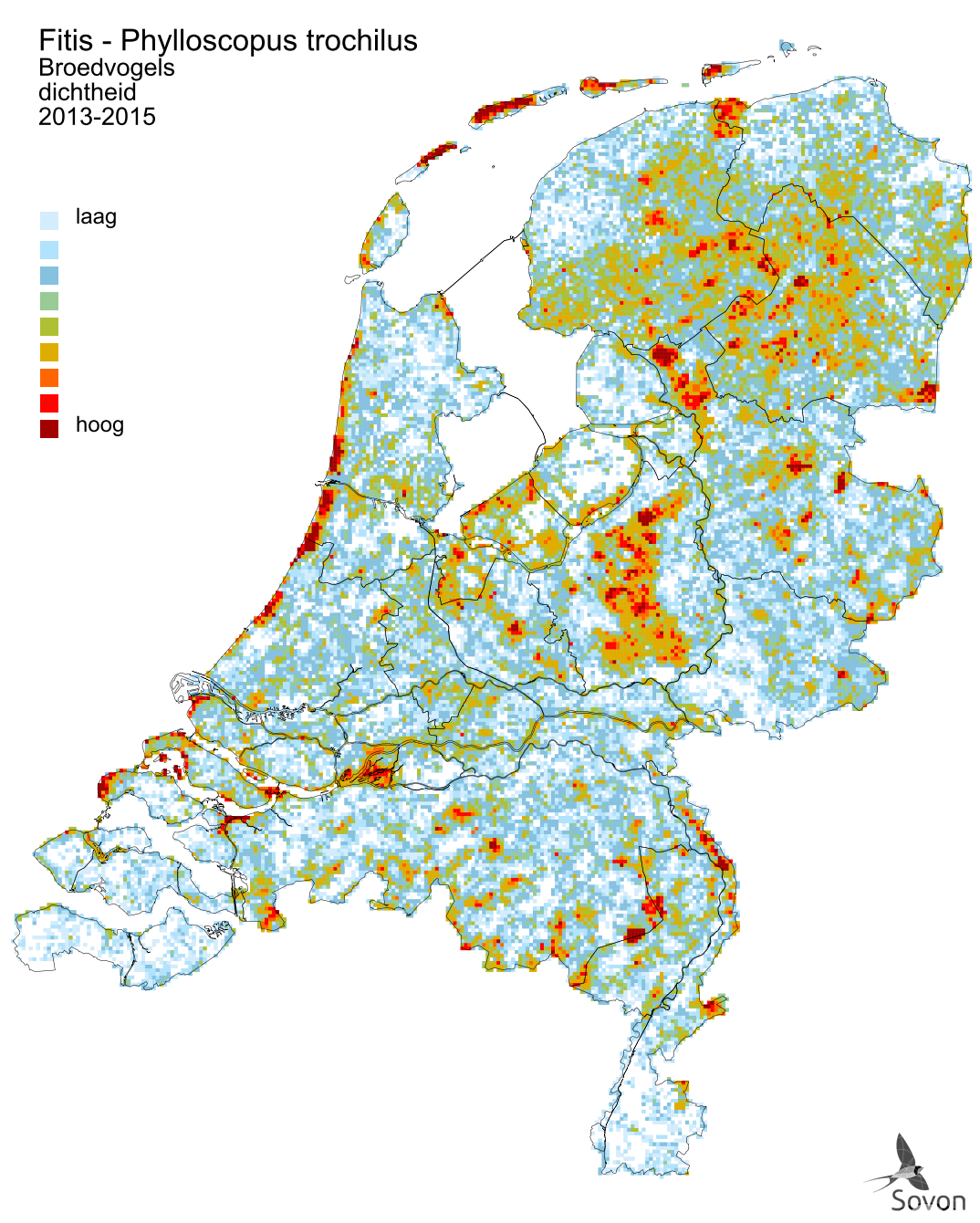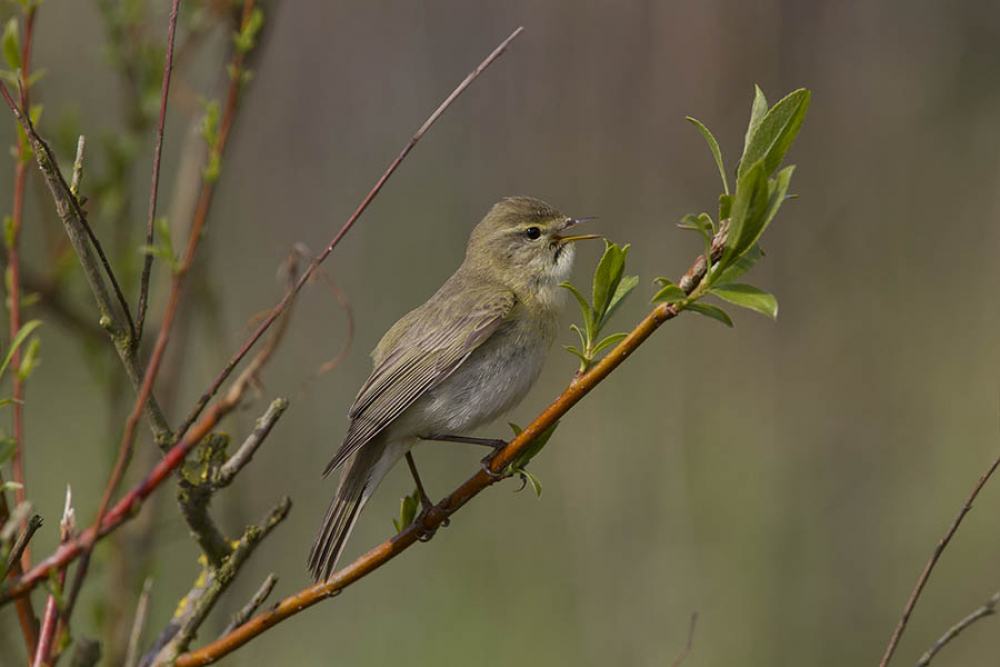Verspreiding en trends
Verspreiding

Deze kaart is gebaseerd op de Vogelatlas van Nederland (Sovon 2018). Weergegeven is de relatieve dichtheid per vierkante kilometer.

Deze kaart is gebaseerd op de Atlas van de Nederlandse Vogels (1987). Per atlasblok van 5x5 km wordt een schatting van de aanwezige aantallen gegeven.
Aantalsontwikkeling
broedvogeltrend
Deze grafiek is gebaseerd op het Meetnet Broedvogels (BMP, MUS, MAS). Weergegeven is de jaarlijkse index van de broedpopulatie (rode punten) en de trendlijn (donker gekleurde lijn).
- vanaf 1990
- significante afname, <5% per jaar (-)
- laatste 12 jaar
- significante afname, <5% per jaar (-)
Broedsucces en overleving
adulten overleving
Deze grafiek is gebaseerd op het Constant Effort Site project (CES). Weergegeven is de jaarlijkse lokale overleving van adulte vogels (met 95% betrouwbaarheidsinterval).
reproductie
Deze grafiek is gebaseerd op het Constant Effort Site project (CES). Weergegeven is de jaarlijkse reproductie index (met 95% betrouwbaarheidsinterval).
Seizoensvoorkomen
seizoenspatroon
Deze grafiek is gebaseerd op LiveAtlas. Weergegeven is de meldingsfrequentie per decade, gemiddeld over de laatste 5 jaren. De meldingsfrequentie is het percentage volledige lijstjes waarop de soort is geregistreerd.
Beschrijving voorkomen
Buiten broedtijd
Hoewel de eerste Fitissen eind maart kunnen arriveren, stromen de Nederlandse broedgebieden vooral in april vol. Tot half mei kunnen noordelijke trekkers passeren. De najaarstrek speelt zich af tussen begin juli en eind september, met pieken half juli-half augustus (vermoedelijk vooral lokale vogels) en eind augustus-begin september (vermoedelijk vooral doortrekkers). De Fitissen die tijdens de trek ons land passeren, komen vooral van de Britse eilanden en uit zuidelijk Scandinavië en volgen een zuidwestelijke trekroute. Na eind september zijn Fitissen schaars.
Broedtijd
De hoogste dichtheid aan Fitissen is te vinden in de duinen, heidevelden en hoogveengebieden met opslag en jonge bosaanplant. In open boerenland en in stedelijk gebied is de dichtheid laag. De landelijke verspreiding is al enkele decennia ongewijzigd. De landelijke aantallen nemen echter af. Dit heeft deels van doen met veranderingen in het beheer van bossen (minder grootschalige kaalkap gevolgd door herplant) en natuurgebieden (verwijdering opslag in duinen en heide). Droogte in de Sahel heeft effect op de winteroverleving.
Vogelrichtlijn
Staat van instandhouding
De Vogelrichtlijn richt zich op de instandhouding van alle natuurlijk in Europa in het wild levende vogelsoorten waaronder de Fitis.
Dit betekent dat de EU-lidstaten maatregelen moeten nemen om de populaties van deze soorten op een niveau te houden of te brengen dat met name beantwoordt aan de ecologische, wetenschappelijke en culturele eisen. Daaronder wordt onder andere een gunstige staat van instandhouding verstaan. Het begrip Staat van instandhouding is zo ongeveer synoniem voor de mate van duurzaamheid of gezondheid van een populatie van een soort.
De Vogelrichtlijn verlangt van de lidstaten dat ze leefgebieden voor vogels in voldoende omvang en kwaliteit in stand houden, waaronder door de aanwijzing van speciale beschermingszones ten behoeve van het Europese Natura 2000-netwerk. Voor de Fitis zijn in Nederland geen speciale beschermingszones aangewezen. De landelijke populatie moet zich wel op een gunstig niveau kunnen handhaven.
Methodiek voor de bepaling van de Staat van instandhouding van vogels
broedvogel
De Staat van Instandhouding van de Fitis als broedvogel in Nederland is matig ongunstig.
| Beoordeling Staat van Instandhouding | ||||
| Verspreiding | Populatie | Leefgebied | Toekomst | Eindoordeel |
| gunstig | matig ongunstig | gunstig | matig ongunstig | matig ongunstig |
niet-broedvogel
De Staat van Instandhouding van de Fitis als niet-broedvogel in Nederland is onbekend.
| Beoordeling Staat van Instandhouding | ||||
| Verspreiding | Populatie | Leefgebied | Toekomst | Eindoordeel |
| onbekend | onbekend | onbekend | onbekend | onbekend |
Aangewezen gebieden
Er zijn geen gebieden aangewezen voor deze soort.
Telrichtlijnen
Broedvogels
Methode
Territoriumkartering
Tijd van het jaar
Begin april t/m half juli
Tijd van de dag
Vooral in de ochtend.
Datumgrenzen, normbezoeken en fusieafstand
| geldige waarnemingen | normbezoeken | minimaal vereist | fusie- | |||||||||
| adult | paar | terr | nest | migrant | 1 | 2 | 3 | seizoen | datumg | datumgrens | afstand | |
| . | . | X | X | JA | 1-6 | 7-10 | 11+ | 1 | 10-4 t/m 25-6 | 100 | ||
Aanwijzingen
Zang [broedcode 2], aangevuld met nestbouw [brc 9] (door vrouwtje, begeleid door – vaak zingend – mannetje), alarm [brc 7], transport van voedsel of ontlastingspakketje [brc 14] (beide partners). Dichtheden kunnen hoog zijn in sommige habitats (halfopen duinen, heide met veel opslag, grienden etc.).
LET OP: doortrek mogelijk tot in mei, en tijdens doortrekgolf soms talrijk zingend in ongeschikte habitat (zoals oud bos zonder verjongingsvlaktes, of kleine stadstuinen).
Bijzonderheden
Voortdurend zacht roepende vogel (vloeiend 'huwiet'), zich laag door de vegetatie telkens in dezelfde richting begevend, is vaak een vrouwtje op weg naar het nest. Let op aanwezigheid nestmateriaal of voedsel in de bek (maar het kan ook een vrouwtje met eieren zijn, 'spoorloos' verdwijnend in vegetatie).
Broedbiologie
Broedt in droge tot vochtige halfopen landschappen met voldoende opslag, van heide tot bos (vooral aanplant, kaalslag), moeras en agrarisch cultuurlandschap. Eileg van begin mei tot in juni. Eén broedsel per jaar, meestal 5-7 eieren, broedduur 12-14 dagen, nestjongenperiode 12-16 dagen. Familie blijft 2-3 weken bijeen.
